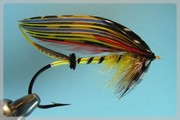I was somewhat taken aback recently when I looked at a number of internet tutorials and videos on the hand
whip finish and noticed that virtually all of them use a method that I used years ago. At some point
in my own tying I changed to another, slightly different approach, one I found in Dave Hughes'
book "American Fly Tying Manual". He also has a very nice description in "Trout Flies" as well, a book that
came along later. The concept is the same, but I find Hughes' method to be superior, especially at
the start of the whip.
Over the years I've heard from tiers who use the whip finish tool who say that they find the tool to
be more precise. This is simply because they are using the more popular method of hand whipping.
It is true that with the conventional method there is a loop formed around the hook at the beginning
that is difficult to control. To see what I mean, watch Gary and Jason Borger's video on-line at
http://www.flyfisherman.com/ftb/jbwhip/.
Note the large loop formed at the beginning, after the first wrap. This can lead to loss of control.
With the method described by Dave Hughes there is no such problem, and it is possible to completely control
the placement of all wraps. If you use a tool I will not try to talk you out of it, it's a very good method.
There is a convenience and flexibility with the hand whip finish however that I would not trade for the world.
If you use the conventional method of hand whipping, give this a try. I did, and changed the way I whip
finished a fly right then and there.
Here is a video of how I execute the
Hand
Whip Finish on a conventional dry fly and here is a video of the
Hand
Whip Finish on a Parachute Dry.

